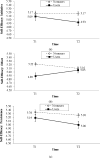Testing the Amotivational Syndrome: Marijuana Use Longitudinally Predicts Lower Self-Efficacy Even After Controlling for Demographics, Personality, and Alcohol and Cigarette Use
- PMID: 28620722
- PMCID: PMC5732901
- DOI: 10.1007/s11121-017-0811-3
Testing the Amotivational Syndrome: Marijuana Use Longitudinally Predicts Lower Self-Efficacy Even After Controlling for Demographics, Personality, and Alcohol and Cigarette Use
Abstract
The marijuana amotivational syndrome posits that cannabis use fosters apathy through the depletion of motivation-based constructs such as self-efficacy. The current study pursued a two-round design to rule out concomitant risk factors responsible for the connection from marijuana intake to lower general self-efficacy. College students (N = 505) completed measures of marijuana use, demographics (age, gender, and race), personality (extraversion, agreeableness, conscientiousness, openness, and neuroticism), other substance use (alcohol and tobacco), and general self-efficacy (initiative, effort, and persistence) in two assessments separated by a month. Hierarchical regression models found that marijuana use forecasted lower initiative and persistence, even after statistically ruling out 13 pertinent baseline covariates including demographics, personality traits, alcohol use, tobacco use, and self-efficacy subscales. A cross-lagged panel model involving initiative, effort, persistence, alcohol use, cigarette use, and marijuana use sought to unravel the temporal precedence of processes. Results showed that only marijuana (but not alcohol or tobacco) intake significantly and longitudinally prompted lower initiative and persistence. Furthermore, in the same model, the opposite temporal direction of events from lower general self-efficacy subscales to marijuana use was untenable. Findings provide partial support for the marijuana amotivational syndrome, underscore marijuana as a risk factor for decreased general self-efficacy, and offer implications and insights for marijuana prevention and future research.
Keywords: Amotivational syndrome; Cross-lagged panel modeling; General self-efficacy; Longitudinal; Marijuana.
Conflict of interest statement
Figures


Similar articles
-
A Comprehensive Examination of the Links between Cannabis Use and Motivation.Subst Use Misuse. 2020;55(7):1155-1164. doi: 10.1080/10826084.2020.1729203. Epub 2020 Feb 26. Subst Use Misuse. 2020. PMID: 32100610
-
Developmental trajectories of Big Five personality traits among adolescents and young adults: Differences by sex, alcohol use, and marijuana use.J Pers. 2022 Oct;90(5):748-761. doi: 10.1111/jopy.12694. Epub 2022 Jan 11. J Pers. 2022. PMID: 34919282 Free PMC article.
-
Factors Associated With Marijuana use and Problems Among College Students in Colorado.Subst Use Misuse. 2018 Feb 23;53(3):477-483. doi: 10.1080/10826084.2017.1341923. Epub 2017 Sep 19. Subst Use Misuse. 2018. PMID: 28925799
-
Changes in undergraduates' marijuana, heavy alcohol and cigarette use following legalization of recreational marijuana use in Oregon.Addiction. 2017 Nov;112(11):1992-2001. doi: 10.1111/add.13906. Epub 2017 Jul 11. Addiction. 2017. PMID: 28613454
-
PERSONALITY AND CIGARETTE SMOKING.Life Sci (1962). 1964 Jul;3:777-92. doi: 10.1016/0024-3205(64)90033-5. Life Sci (1962). 1964. PMID: 14203979 Review. No abstract available.
Cited by
-
Predictive impact of different acute cannabis intoxication effects with regard to abstinence motivation and cessation of use.Sci Rep. 2023 Jan 13;13(1):709. doi: 10.1038/s41598-023-27592-6. Sci Rep. 2023. PMID: 36639397 Free PMC article.
-
The Effects of Adolescent Cannabis Use on Psychosocial Functioning: A Critical Review of the Evidence.Psychiatr Clin North Am. 2023 Dec;46(4):677-689. doi: 10.1016/j.psc.2023.03.011. Psychiatr Clin North Am. 2023. PMID: 37879831 Free PMC article. Review.
-
Chronic Δ9-tetrahydrocannabinol exposure in adolescent nonhuman primates: persistent abnormalities in economic demand and brain functional connectivity.Neuropsychopharmacology. 2025 Feb;50(3):576-585. doi: 10.1038/s41386-024-02024-9. Epub 2024 Nov 13. Neuropsychopharmacology. 2025. PMID: 39538014
-
Past Year Cannabis Use Among Norwegian Adolescents: Time Trends Based on the Ungdata Surveys 2010-2019.Front Psychiatry. 2021 Mar 16;12:627479. doi: 10.3389/fpsyt.2021.627479. eCollection 2021. Front Psychiatry. 2021. PMID: 33796032 Free PMC article.
-
Substance Use and Educational Impacts in Youth With and Without Chronic Illness.Am J Prev Med. 2024 Feb;66(2):279-290. doi: 10.1016/j.amepre.2023.09.029. Epub 2023 Oct 4. Am J Prev Med. 2024. PMID: 37802307 Free PMC article.
References
-
- Ajzen I. The theory of planned behavior. Organizational behavior and human decision processes. 1991;50(2):179–211.
-
- Bandura A. Self-efficacy: Toward a unifying theory of behavioral change. Psychological Review. 1977;84(2):191–215. - PubMed
Publication types
MeSH terms
Grants and funding
LinkOut - more resources
Full Text Sources
Other Literature Sources
Medical

